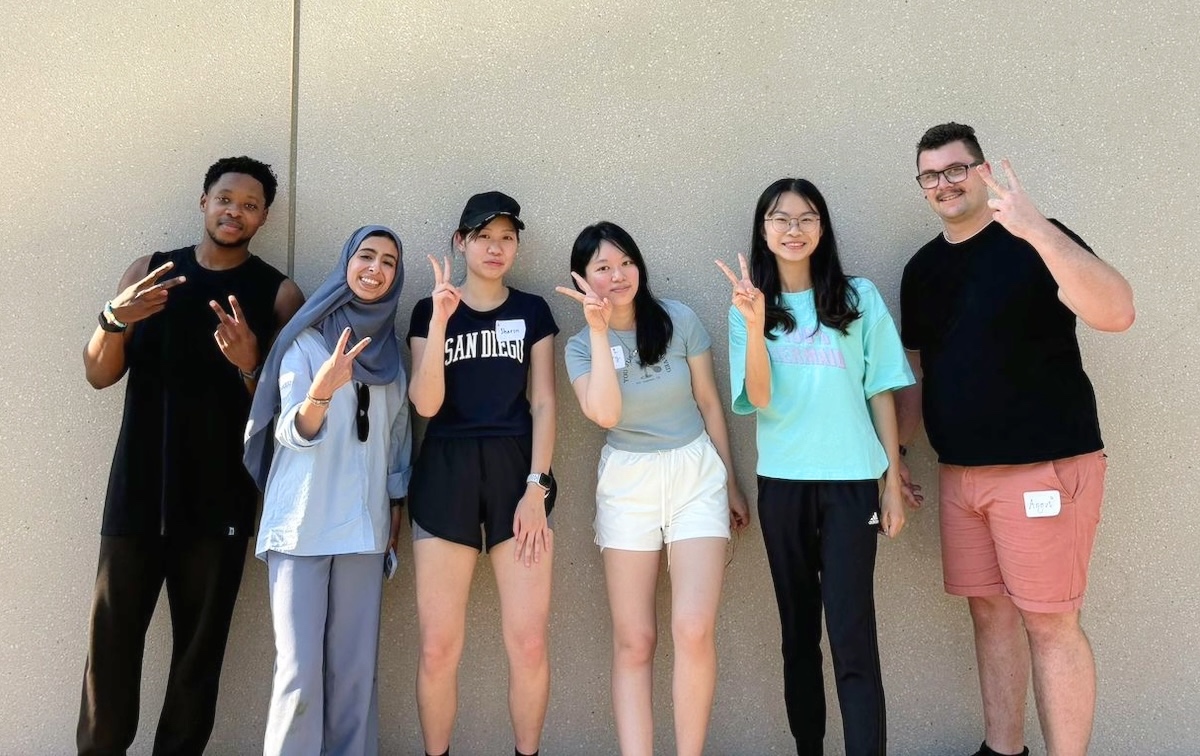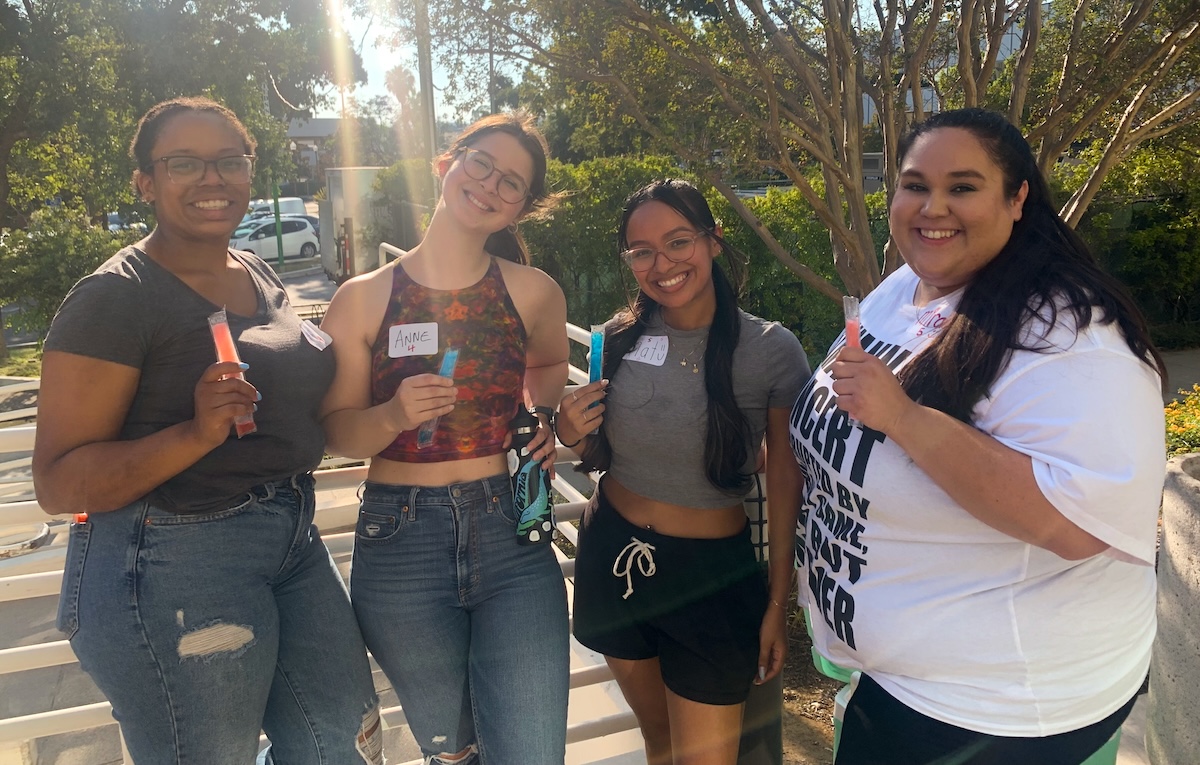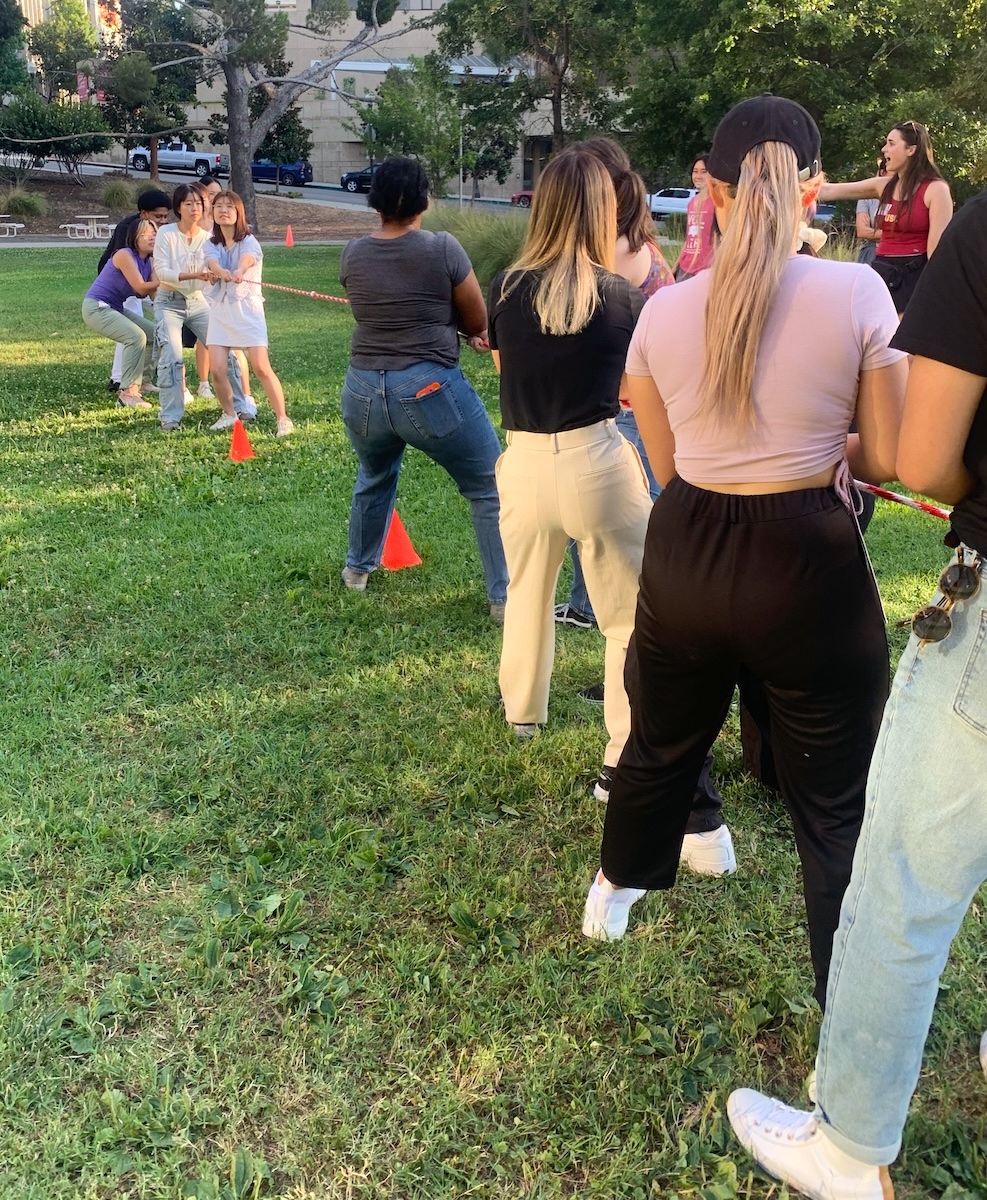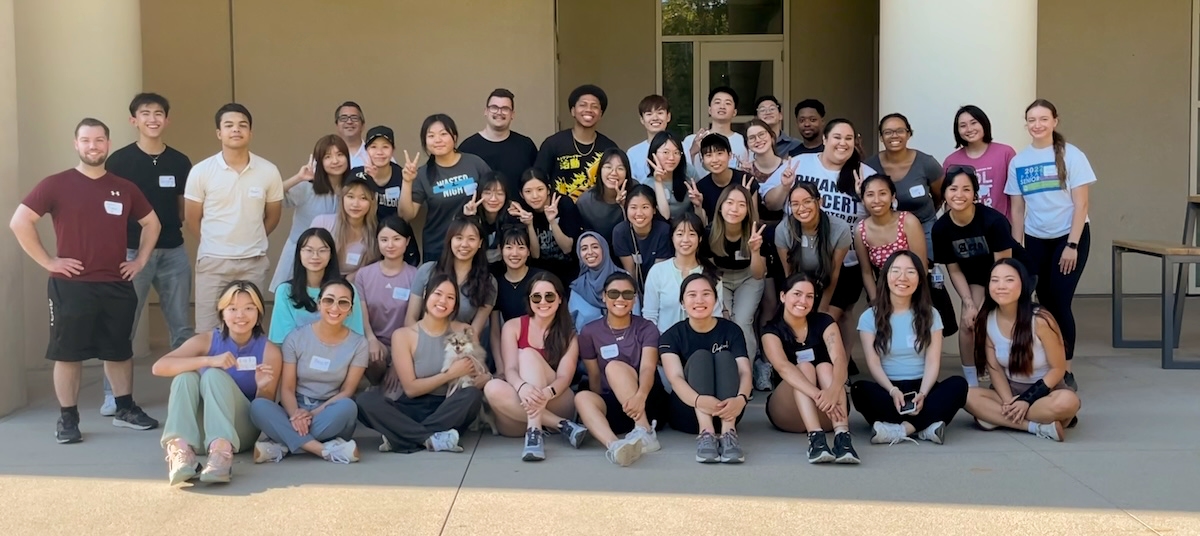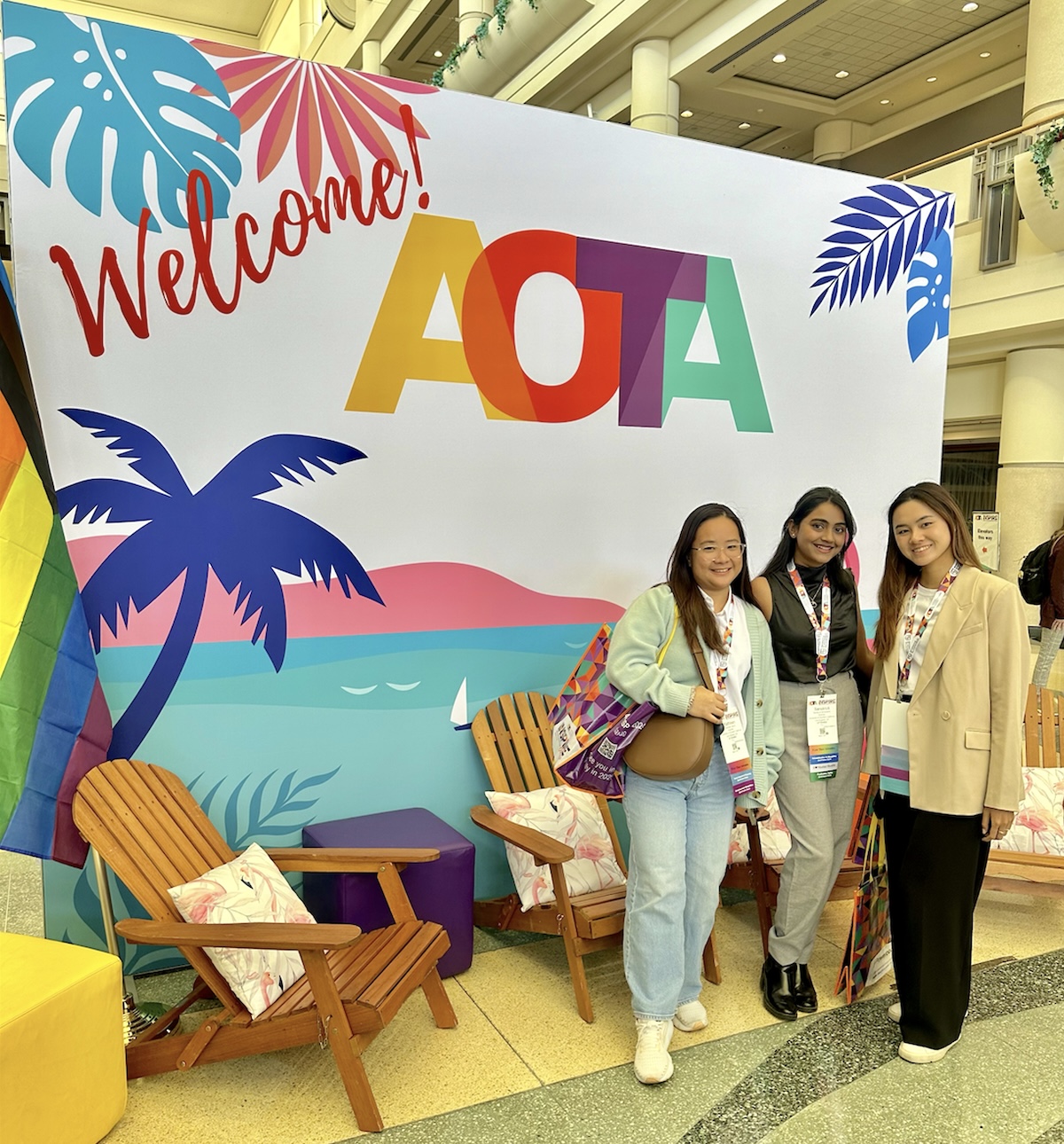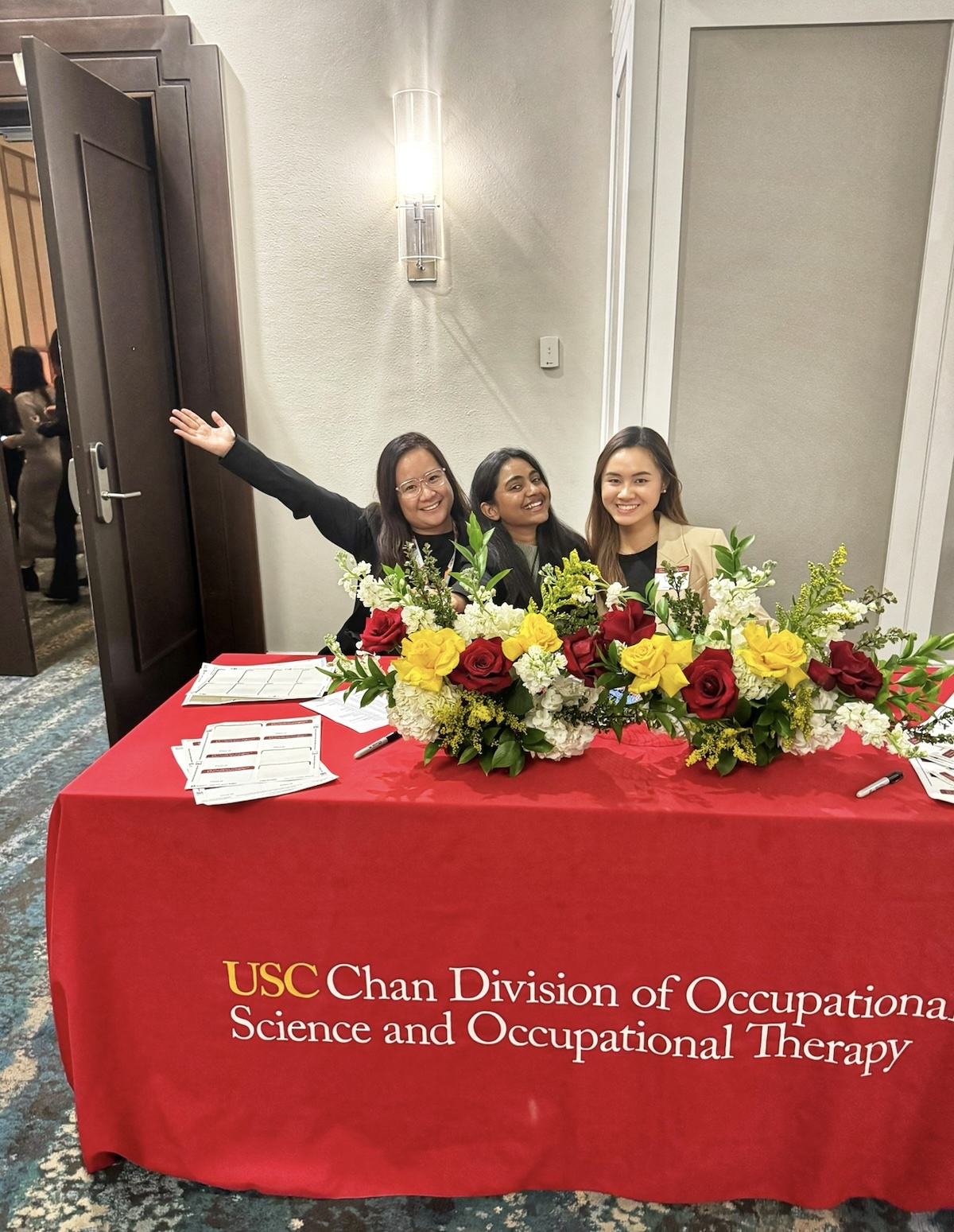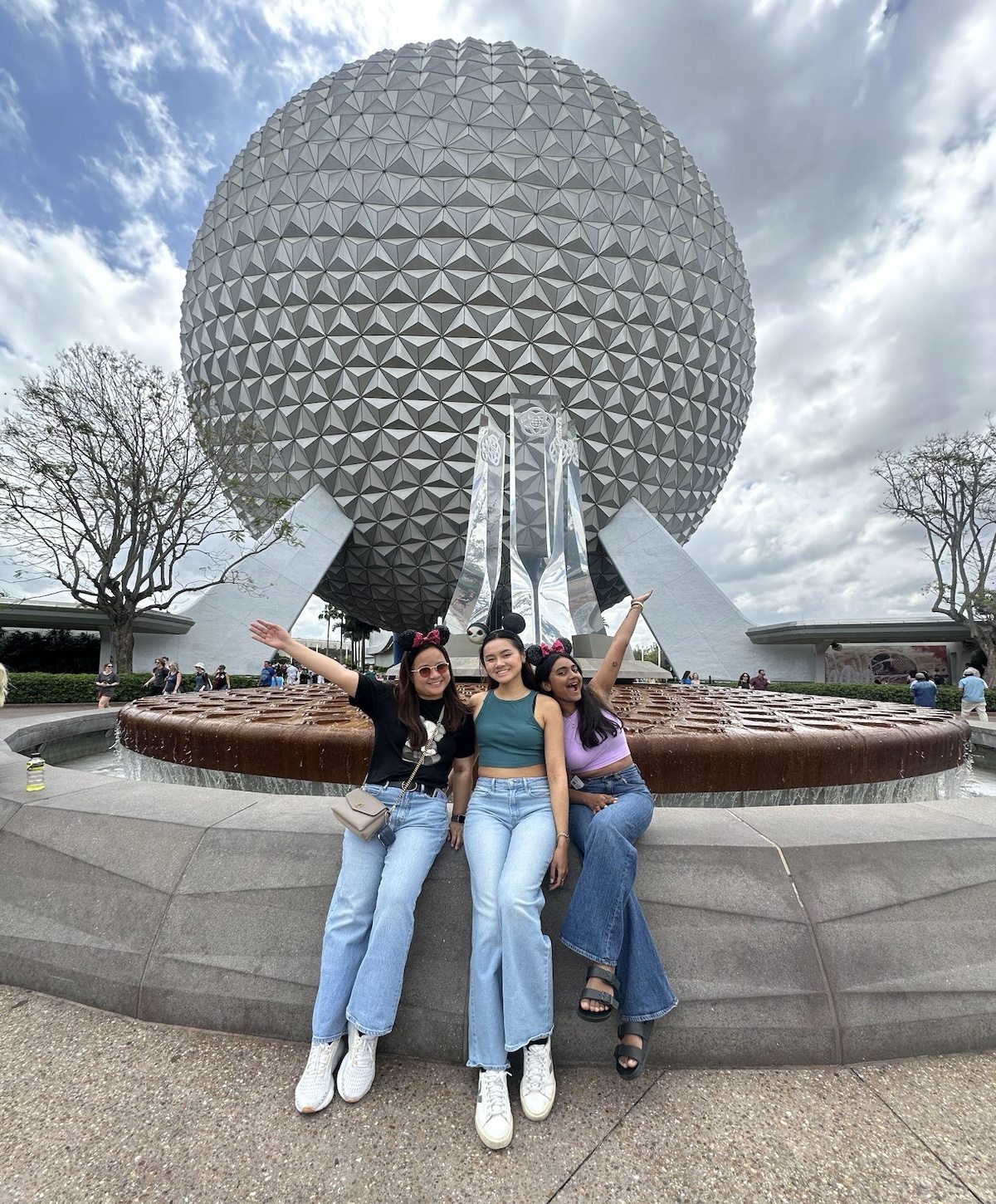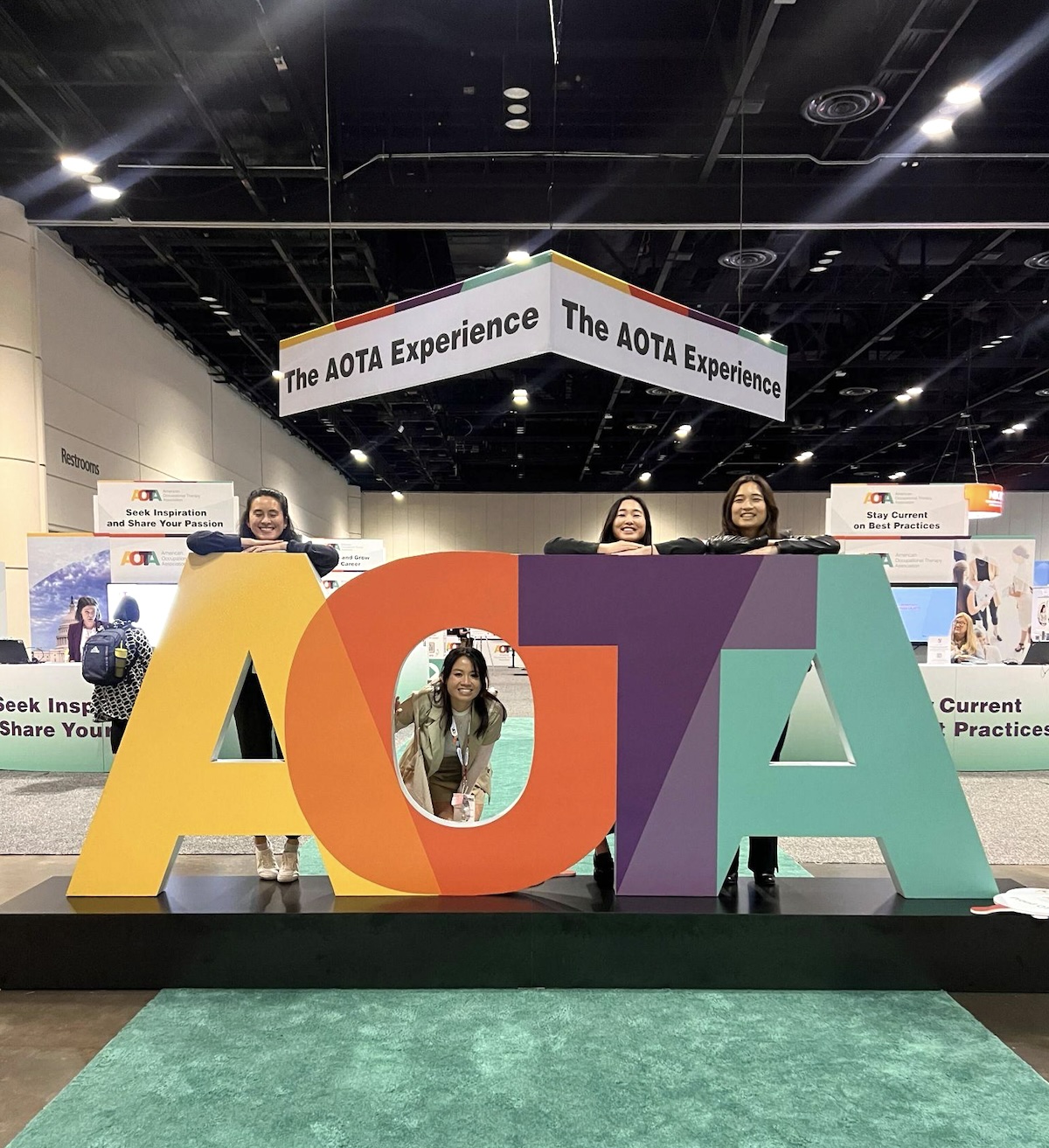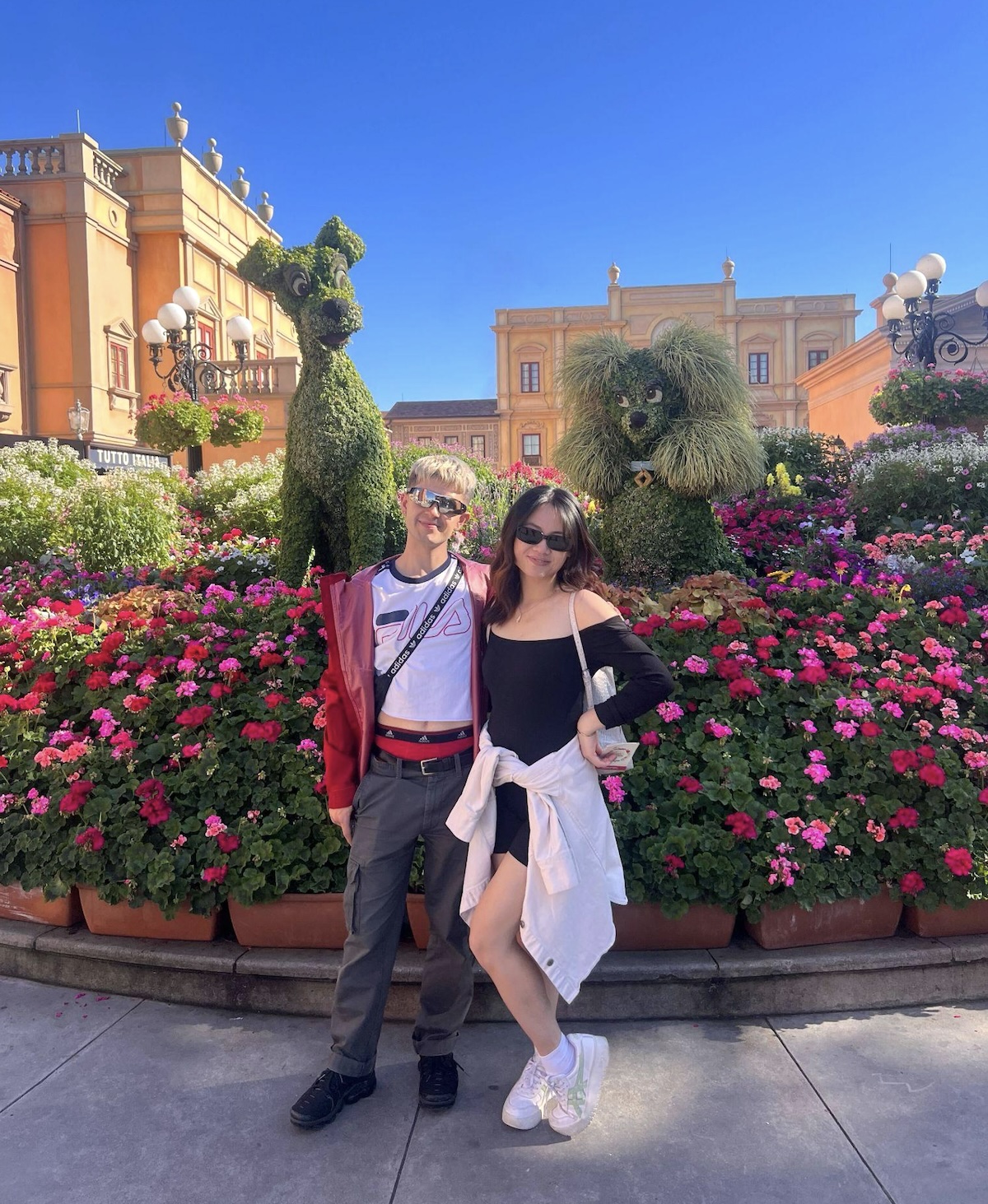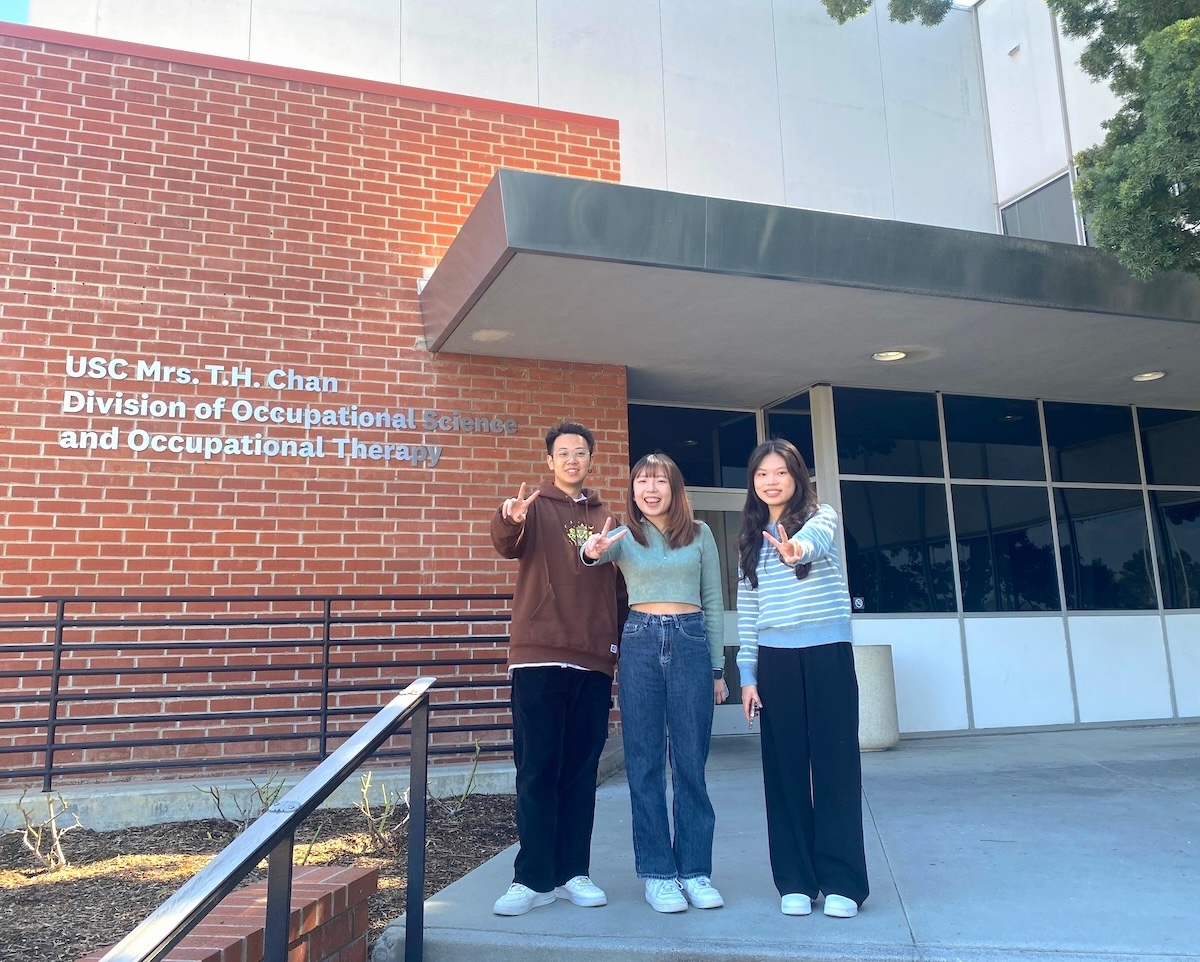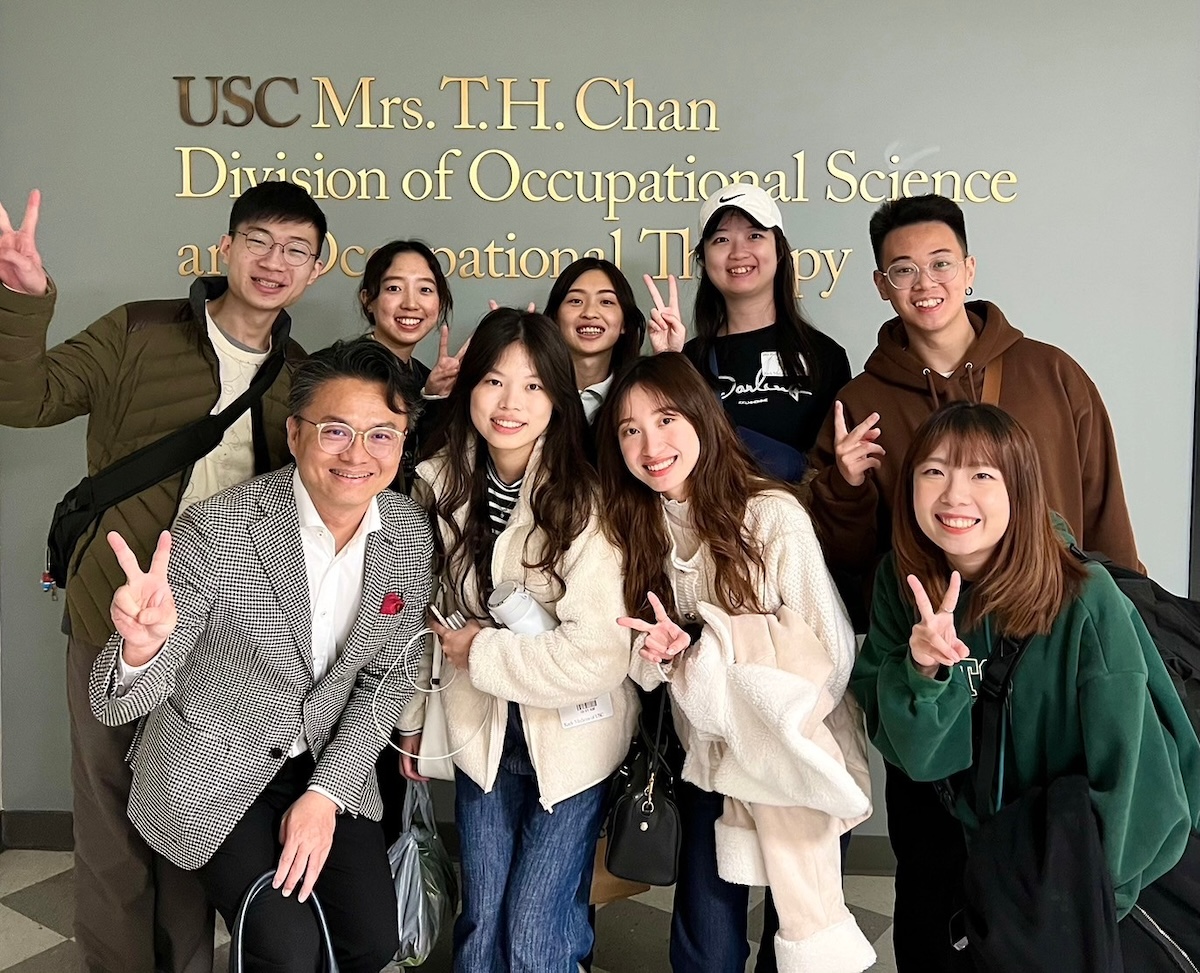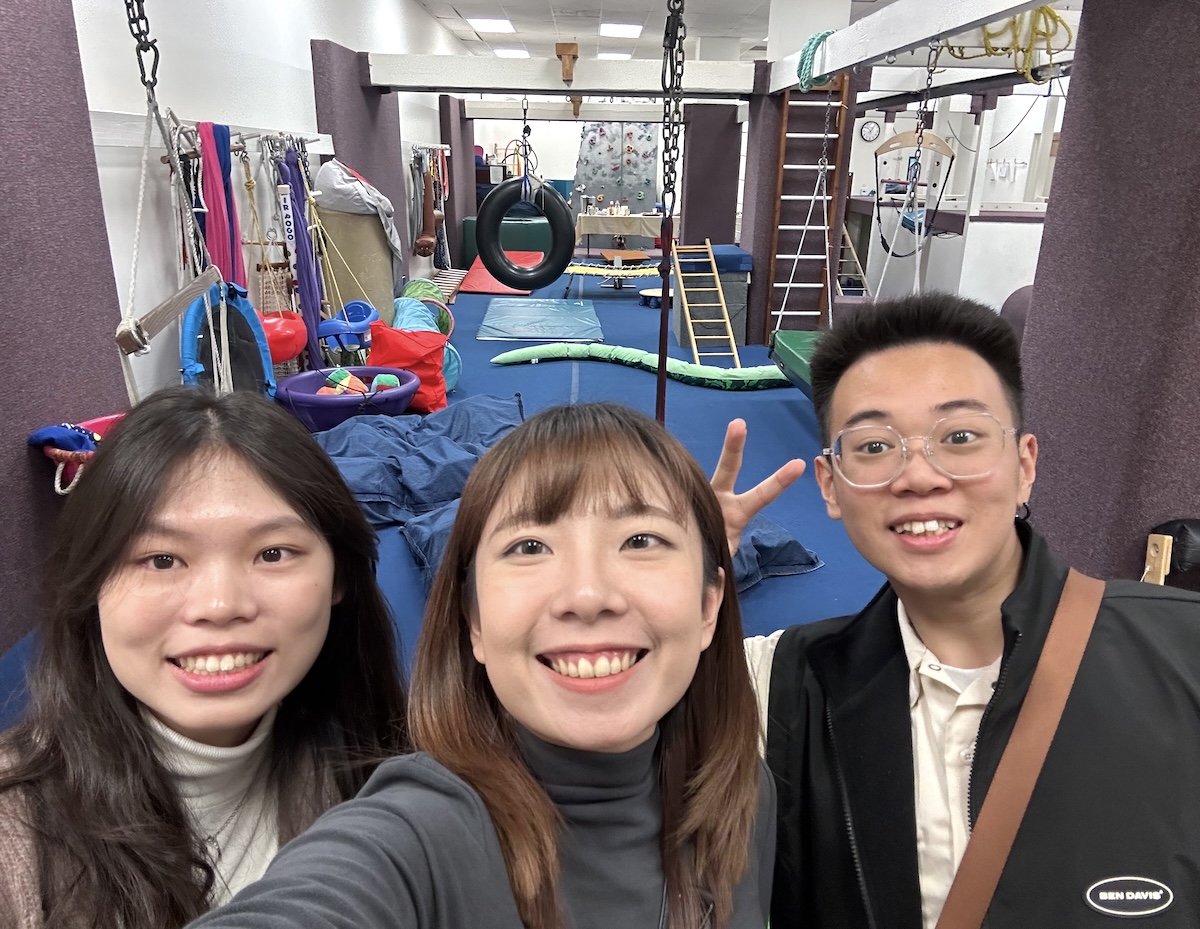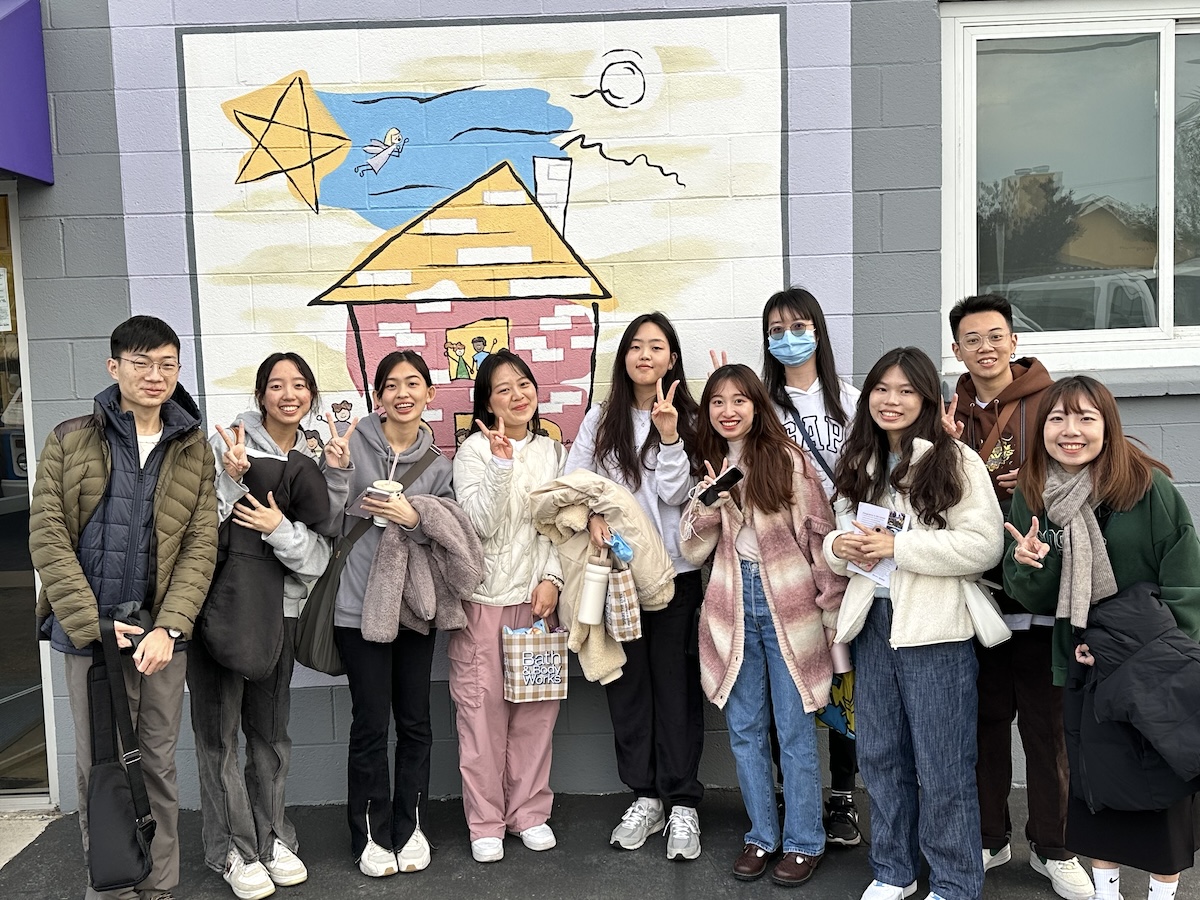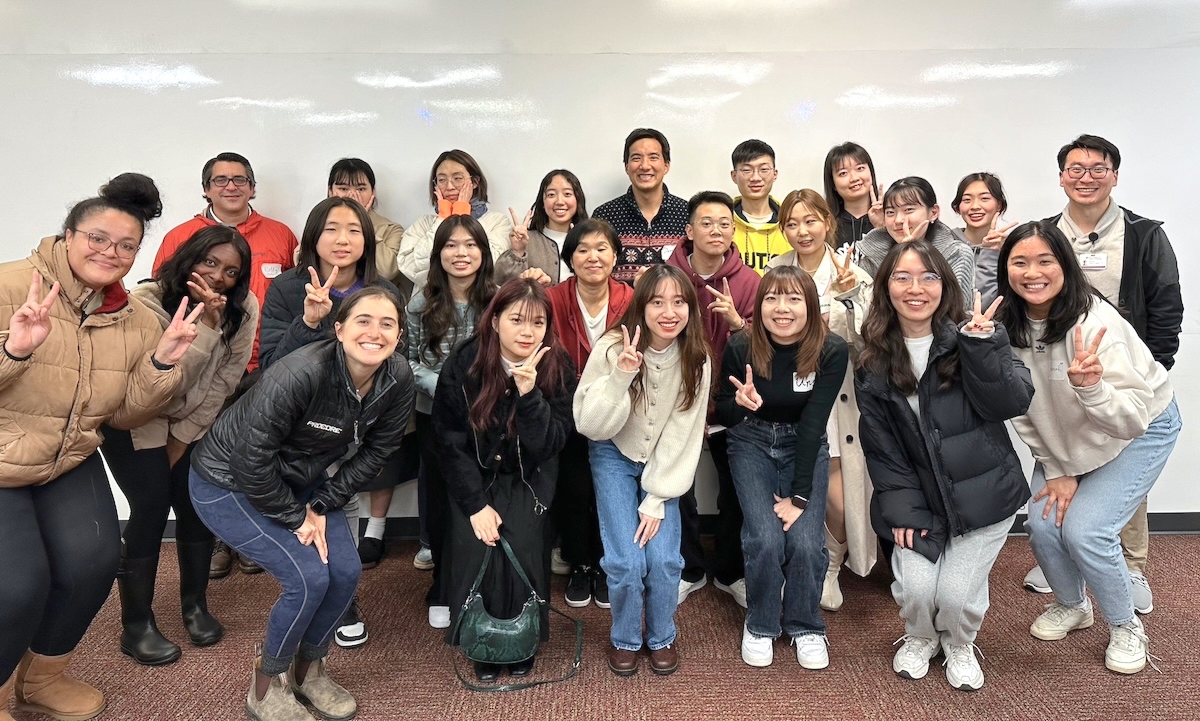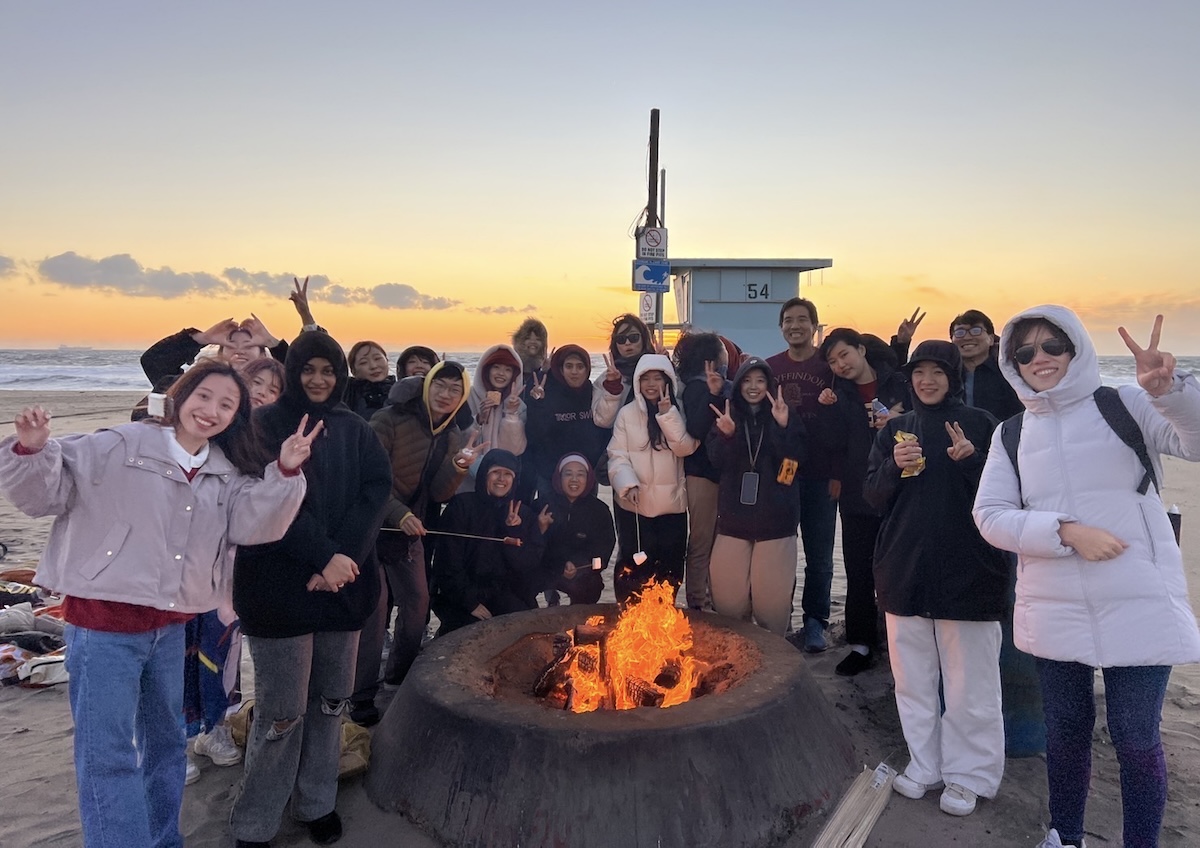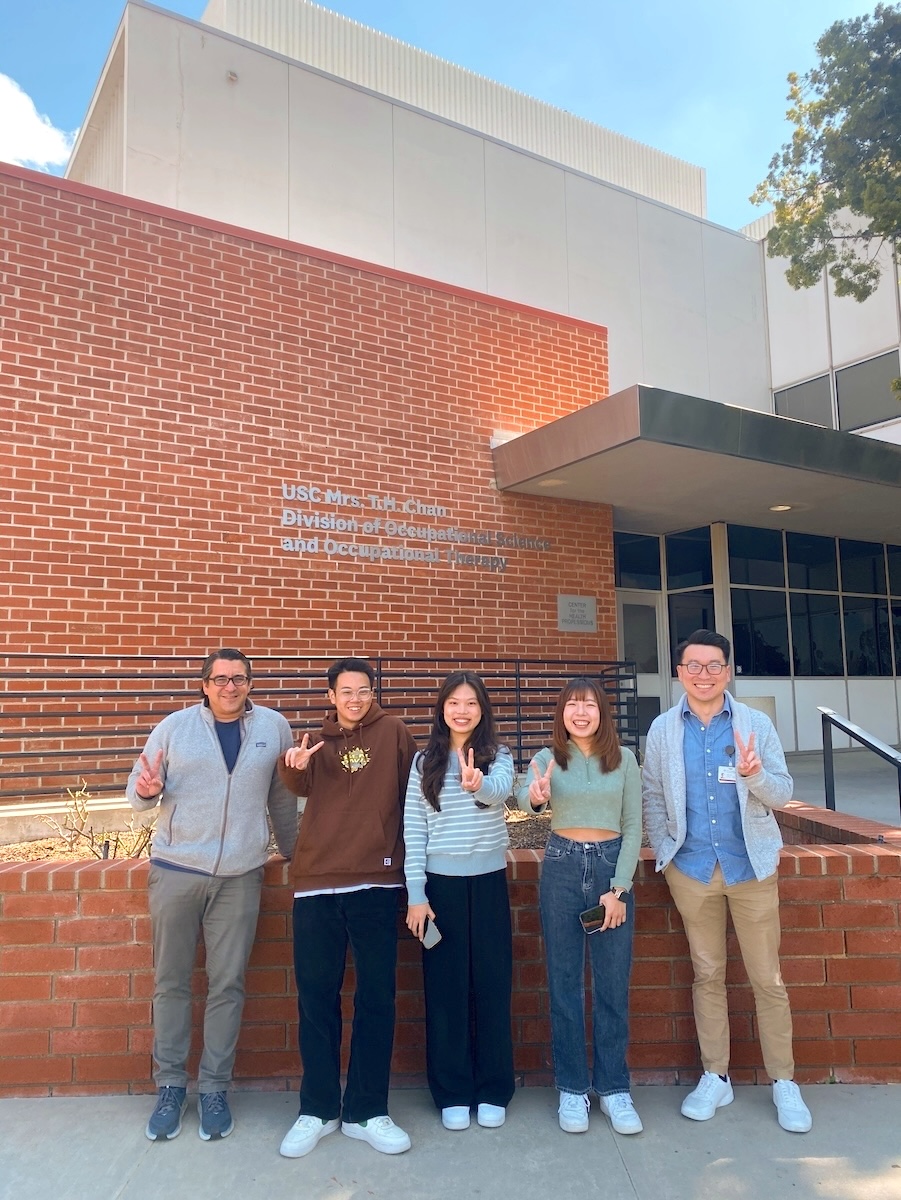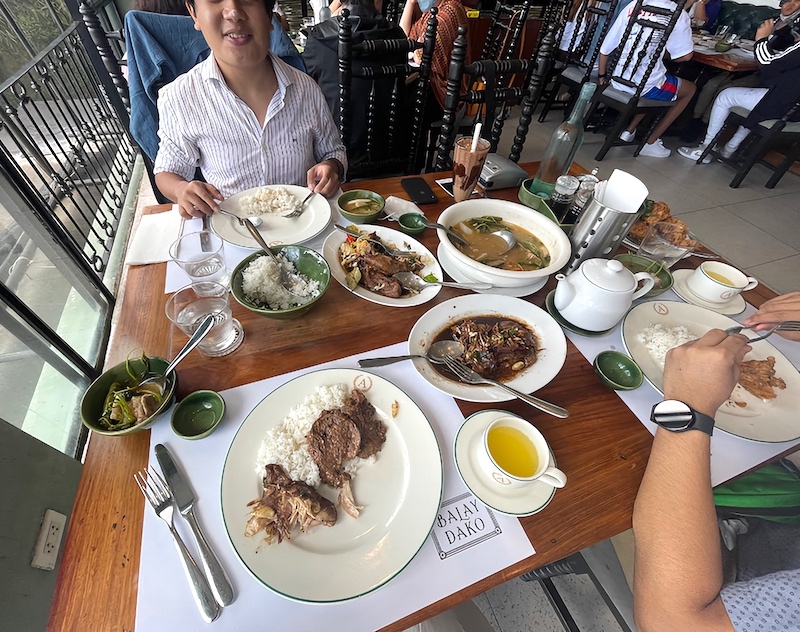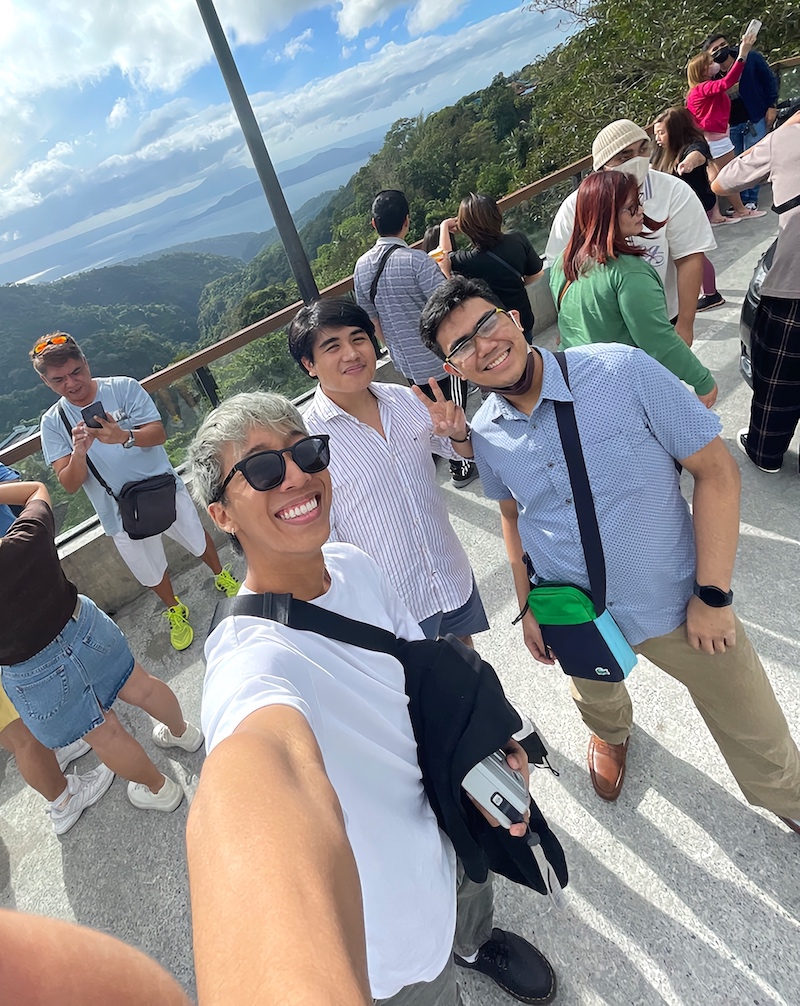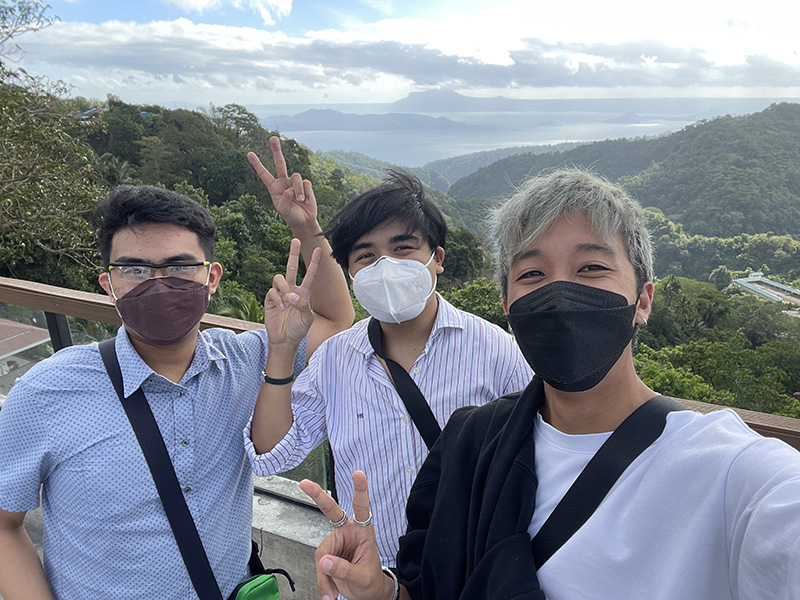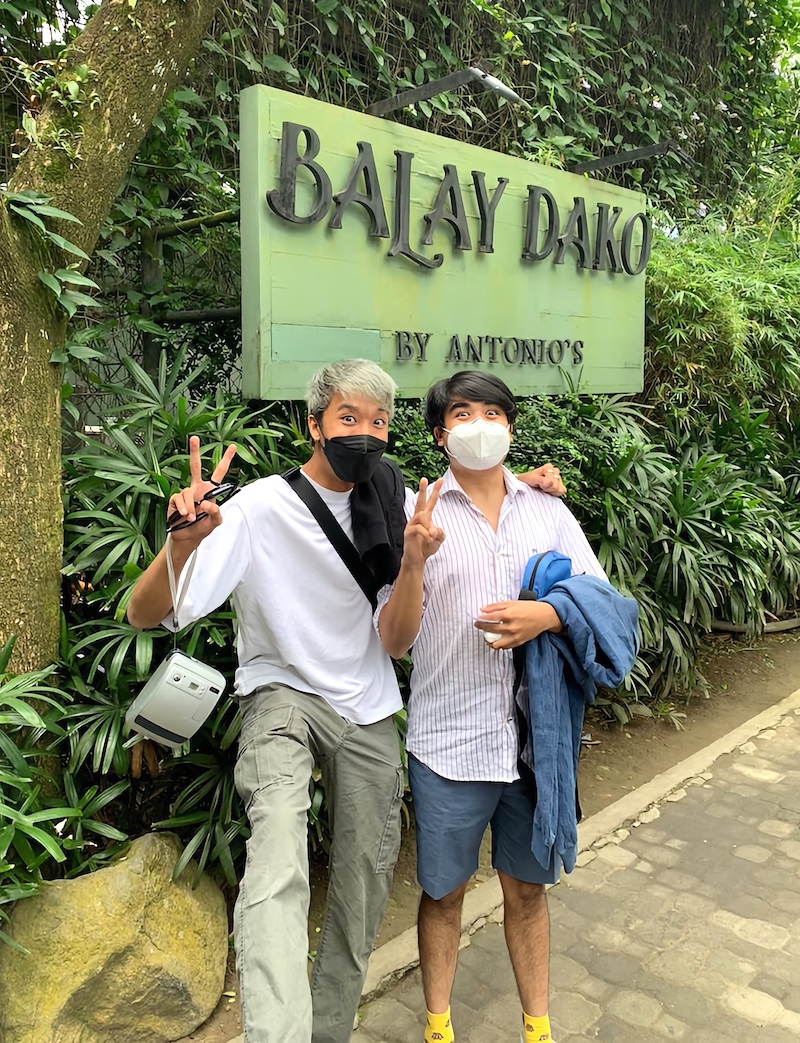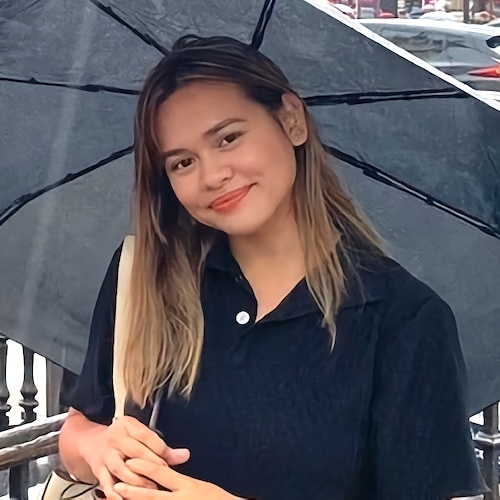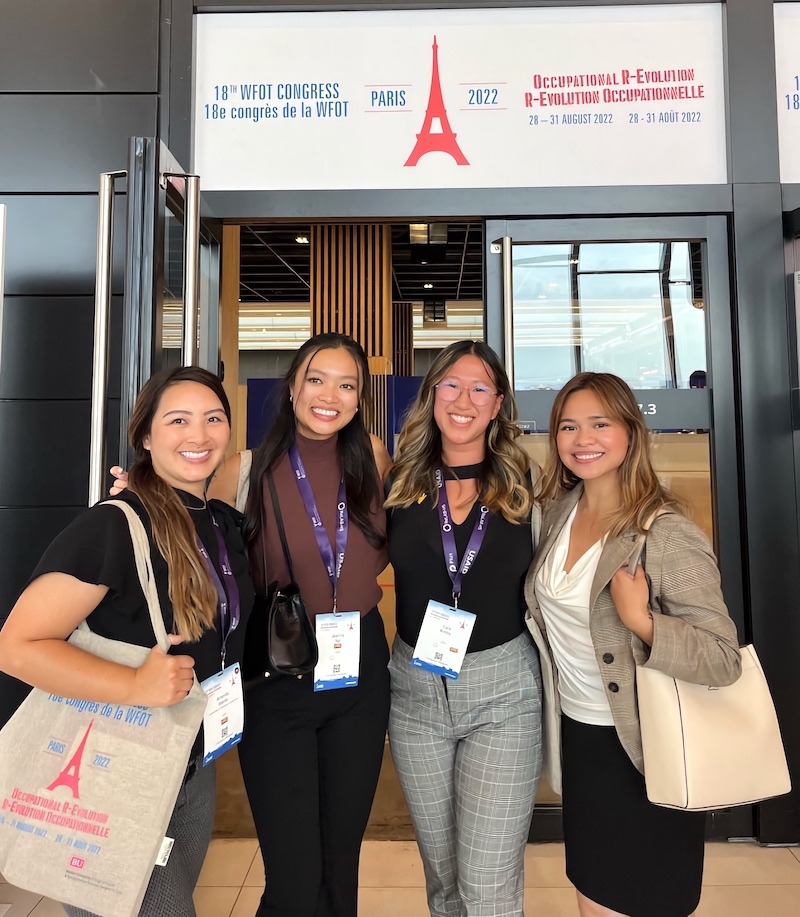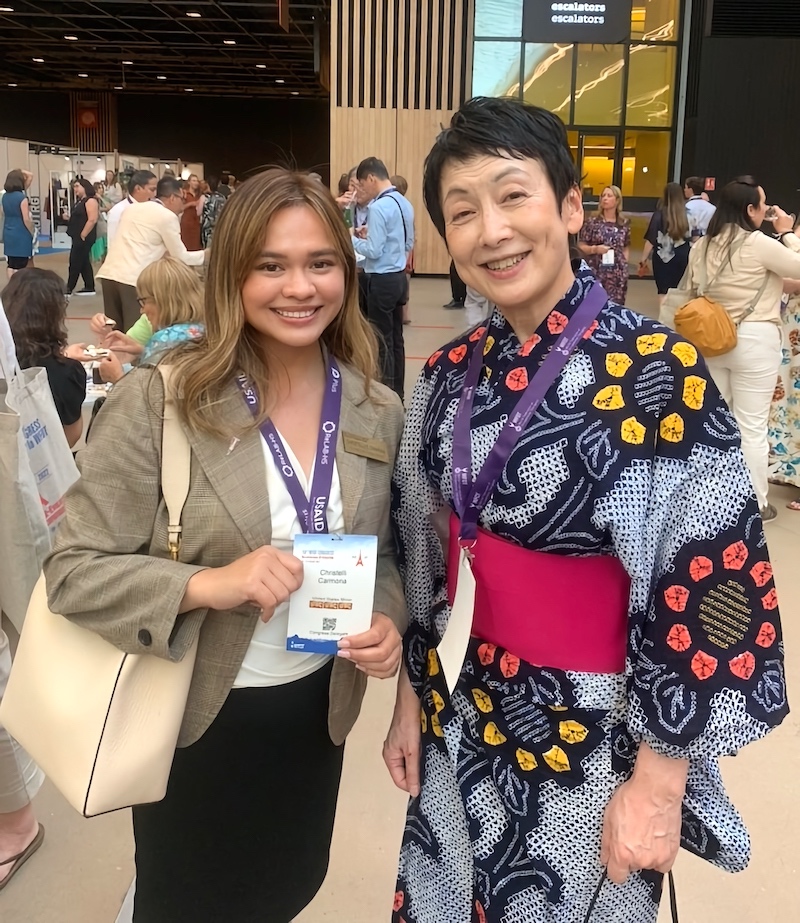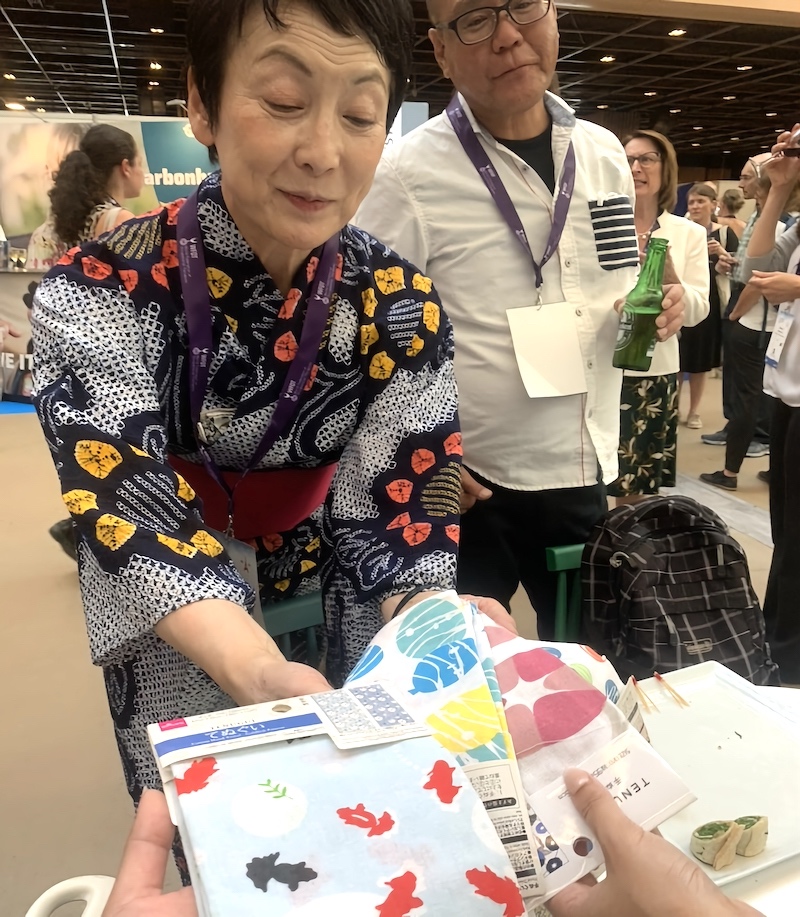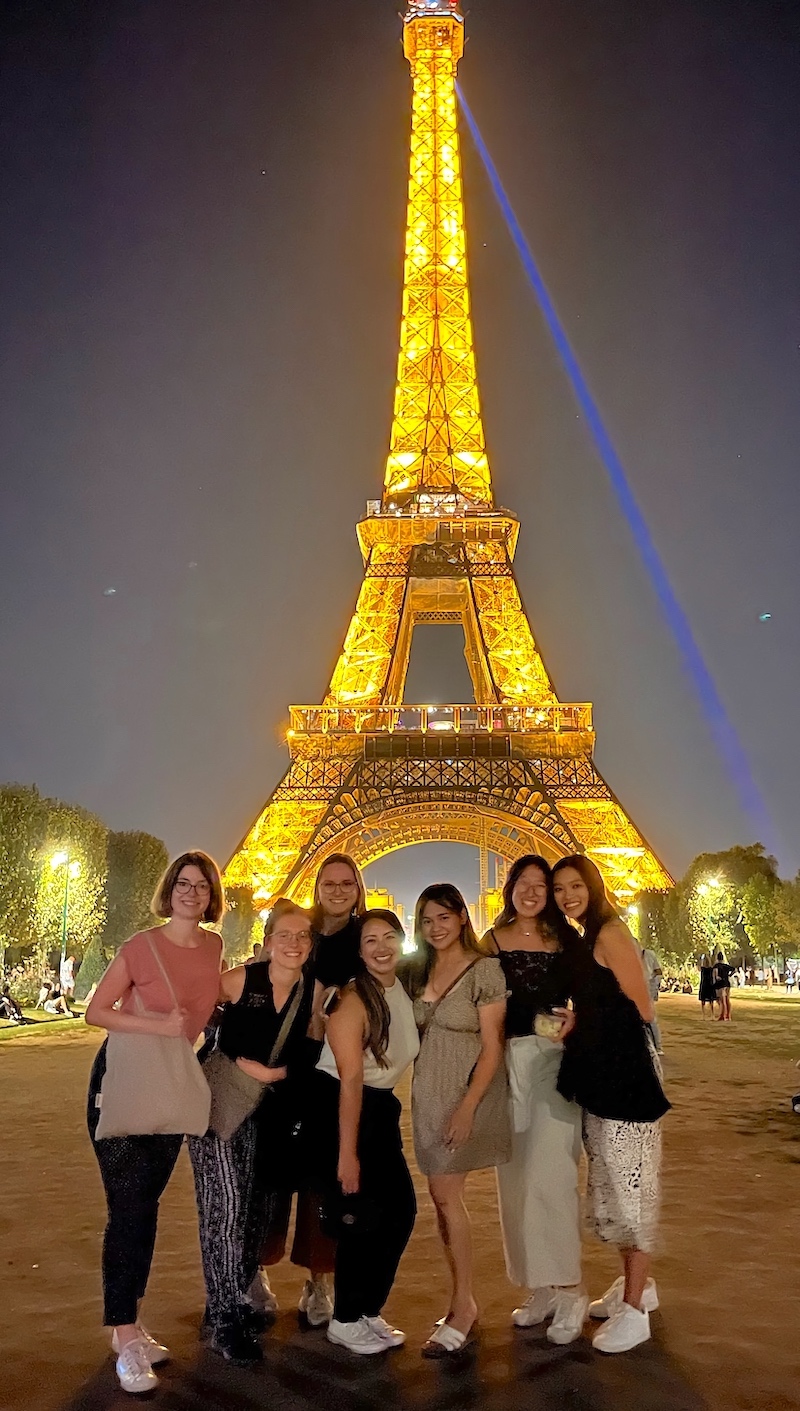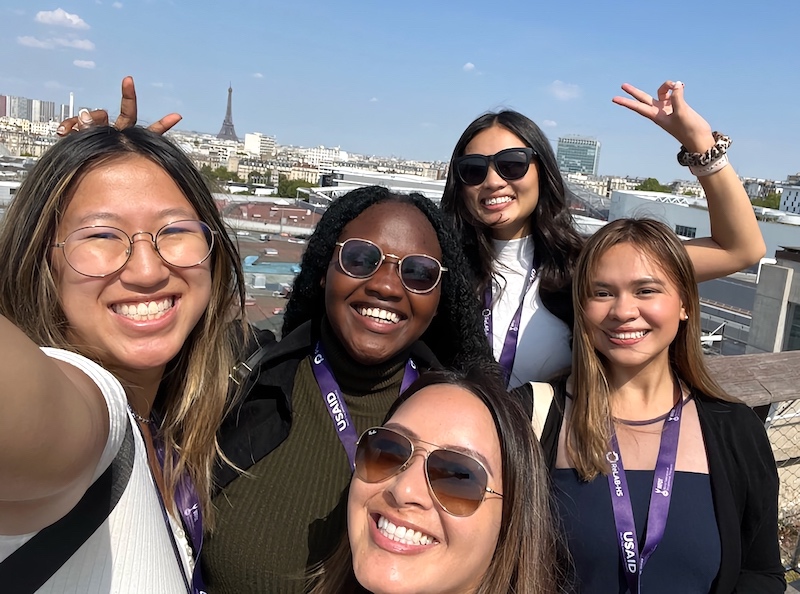Student Blog
Global Initiatives Team
The Summer Olympics at USC Chan ⟩
August 2, 2024, by Global Initiatives Team
By Alyssa Dharmawan (E-OTD ’26)
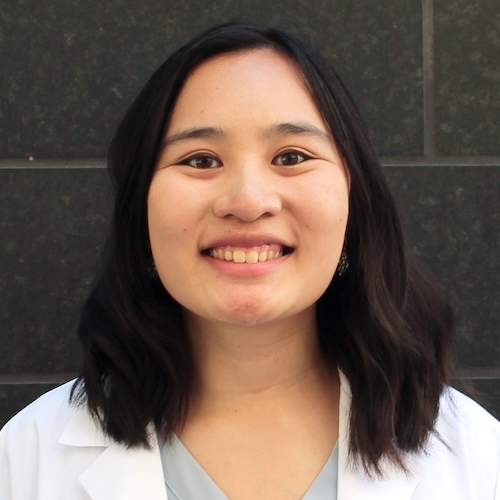
Alyssa Dharmawan
In the world of sports, the Summer Olympics represents a culmination of athletic skill, global unity, and cultural celebrations. Athletes from around the world compete in a diverse range of sports and foster a sense of global community, with the pursuit of excellence and sportsmanship. On July 8th, 2024, Global Initiatives and the Occupational Therapy and Science Council (OTSC) hosted a Summer Olympics event, where students from USC Chan and international OT students from the Summer Occupational Therapy Immersion (SOTI) Program came together and played summer-themed games. Teams were randomized to mix SOTI and Chan students, in order to foster camaraderie among the two groups.
From July 1–31, the 2024 Summer Occupational Therapy Immersion program welcomed 66 OT students and practitioners from 22 different countries across 5 continents. During this 4 week summer program, participants learn about occupational therapy and occupational science in the United States through lectures, site visits, and small group discussions while building global connections and meaningful relationships.
Serving as the Co-Chair for OTSC and working in the Global Initiatives office inspired me to form a committee to create a fun summer event for the USC Chan students and SOTI participants. OTSC’s E-OTD Representative, Catherine Picard, shares how the inspiration of the Summer Olympics contributed to its success: “The inspiration for creating the Summer Olympics stemmed from a desire to foster connections and camaraderie among Chan students from different cohorts, and partnering with Global Initiatives made it a natural choice to include SOTI students, providing a unique opportunity for everyone to socialize and have fun together. Creating a sense of community is integral to USC Chan’s mission, and the Summer Olympics offered a platform for friendly competition, shared experiences, and lasting connections.”
At the beginning of the event, all participants were divided into 5 teams, with each group coming up with a team name, such as Champions, Moho Madness, Pikachu, 4 the Win!, and Gimme 5!. Soon afterwards, teams rotated to play a variety of games such as water balloon tosses, ring toss, dodgeball, corn hole, and volleyball rallies.
Team MOHO Madness: Jowy Cenat, E-OTD ’26; Nourah Alflayyeh, Saudi Arabia; Tsz Ying (Sharon) Li, Hong Kong; Christy Yi, Hong Kong; Kelly Chang, Macau; and Angus Hoadley, Australia
The games ensured that all members of different skill levels and abilities could participate and have an opportunity to engage with their team members. Wing Gi (Venus) Leung, a SOTI participant from Hong Kong, shares her experience: “The Summer Olympics [was] fun [to] play sports without competing too much. Being a person who [isn’t] really into sports, my teammates actively involved me.”
Out of all the games played at the Summer Olympics, volleyball was the most popular. Crispin Huang, a SOTI participant from Hong Kong shares: “[V]olleyball was my favorite game. It was fun to keep the volleyball in the air without letting it touch the ground, despite the sun constantly shining into our eyes. It was both thrilling and hilarious — each time the ball wobbled in the air, my heart raced as I kept shouting to my teammates, ‘Just hit it high so the others have time to react!’ I couldn’t help but laugh at the near-misses and the countless fumbles. It was, of course, a very inclusive game, as it required participation from all team members, no matter our experience in volleyball. In the end, we managed to keep the ball in the air for over 23 hits, which, in my opinion, is quite a milestone as it was the first time for the majority of us to touch a volleyball.”
After teams completed each game, everyone was treated with OTterPops and had an opportunity to socialize and engage in more games, until the final game of the Summer Olympics: Tug of War. During the last game of tug of war, teams went head-to-head tournament style to see who would be the last team standing. The winners of the final game of Tug of War were awarded team prizes!
Megan Mills E-OTD ’26, Anne Kenney E-OTD ’26, Natalie Sanchez E-OTD ’26, and Miranda Marquez E-OTD ’26 enjoying OTterpops
It all came down to two teams: Champions and Gimme 5! The big question was which team would be crowned the winner of the Tug of War and take home the grand prizes? After an exhilarating match, Gimme 5! emerged as the winners, demonstrating amazing teamwork and strategy to come on top.
Winners of the Summer Olympics Tug of War team Gimme 5! Wing Sum (Kewpie) Chor, Hong Kong; Miranda Marquez, E-OTD ’26; Natalie Sanchez, E-OTD ’26; Weng U (Caroline) Chan, Macau; and Colton Fraser E-OTD ’26 with their prizes
After a fun-filled afternoon of games and socializing under the bright sun, the participants reflected on their experience participating in the Summer Olympics and fostering connections:
“I love [that] this event lets us interact with USC students by playing games. I particularly love tug of war because it gives off a team building atmosphere. When we work together it is easier to get closer with each other. I was impressed by the variety of games such as volleyball and water balloon tosses. [Overall] I love the event a lot.”
— Caroline Chan, Macau
“[The Summer Olympics] was a really fun way to get to know USC OT students! They were all so energetic and lovely. Plus it was nice to see how good friends you all were with each other as well.”
— Nourah Alflayyeh, Saudi Arabia
“[The Summer Olympics] was a lot of fun, I got to meet a lot of new people not only from the SOTI program, but also people from different cohorts from USC Chan. It was a great time playing games and trying to come up with strategies to win. My team got to know each other fast and recognized each other’s strengths and used that to our advantage. Just the overall team work and coming together was awesome! I loved how we were just cheering and rooting for each other the entire event. We all got so close and even exchanged contact info at the end to keep in touch.”
— Miranda Marquez, E-OTD ’26
Serving as the Co-Chair for OTSC and working in Global Initiatives places me in a unique position to foster relationships within the USC Chan community and build global connections with the SOTI participants. I am so honored to have an opportunity to build a sense of community locally and internationally through a shared love of the game with this event. The Summer Olympics would have not been possible without the hardwork and dedication from the incredible team of students from Global Initiatives and OTSC’s executive board members as well as the support of Dr. Danny Park. A special thank you goes to Bea Gee, Anna Glenn, Annika Pham, Catherine Picard, Keni Tsuno, Xiaorong Wang and Jackie Villa.
⋯
Igniting Passion, Building Bridges: AOTA Orlando Chronicles! PP-MA & First-year E-OTD Perspectives ⟩
April 12, 2024, by Global Initiatives Team
By: Kathleen Jayne (PP-MA ’24), Wai Nga Vera Kwok (PP-MA ’24), Sanskruti Sonawane (PP-MA ’24), & Lydia Hong (E-OTD ’26)
Sanskruti: The AOTA conference was a dynamic hub of knowledge seekers, and I was thrilled to be there with my classmates Kath and Vera. We dove into sessions, starting with “Evidence-based strategies to assess and treat neuro-vision deficits in brain injury” by Dr. Sanchala Sen. This session broadened my understanding of the various other fields in OT. Post-session, I had a very insightful and wholesome conversation with Dr. Sen; it instilled in me a sense of pride and motivation after attending a wonderful lecture of a fellow Indian who has made a noteworthy contribution to the field of OT. Another highlight was the session on “Lymphedema and chronic edema in an inpatient acute care program” by Sarah Colwell and Amy Sommerville. Their engaging presentation sparked my interest in working with the lymphedema population. The expo hall was a bustling space where we explored different stalls and had a refreshing lunch. Later, I attended “Learning to administer the FUEL (Functional Upper Extremity Levels)” by Dr. Daniel Geller, an assistant professor at Columbia University. While this lecture explained the scale of FUEL, it also gave me a sense of understanding of what we do and why we do it.
Day two brought more enriching sessions, including “OT Intervention for Bladder and Bowel Dysfunction” and a fascinating lecture on blending technology and music for students with special needs, presented by Mary Hager. As someone involved in the Lifestyle Redesign Graduate Certificate program, “Promoting Sleep and Rest to Improve Outcomes & Quality of Life for Older Adults in Long Term Care” provided valuable insights and techniques for my practice. Learning about sleep pattern changes, conducting various sleep screens and assessments, and discovering new techniques for promoting sleep and rest will greatly enhance my ability to improve outcomes and quality of life for older adults.
Kath: AOTA Inspire offered a range of topics, but as I envision myself working in pediatric care, I focused on sessions related to this setting. It was tough deciding which ones to attend because they all seemed valuable. Two sessions stood out for me: Designing sensory-informed trauma responsive interventions in pediatric settings and Combining SI with other approaches like Executive Function, NDT and behavioral approach. Having previously worked in a US schools setting, I gained insights into group homes and foster care, which are not common in the Philippines, my home country. These sessions provided me with a deeper understanding of how to support my future clients effectively. The SI session was particularly engaging as well as it explored combining sensory integration with different therapeutic approaches. Overall, the conference was a fantastic learning experience, and I can’t wait to apply these insights in my practice.
Vera: Scrolling through the list of sessions during the AOTA conference, I had a hard time deciding which ones to attend as so many of them are useful and interesting. I ended up choosing topics that are more related to my current clinical placement at an outpatient pediatric clinic where I see children with sensory processing issues and traumatic past experiences. I attended some courses related to pediatric mental health and trauma-informed care. One of them was a course on sensory-informed, trauma-responsive tiered support. The speaker adopted the tiered approach and introduced interventions for children who experienced childhood trauma. It was eye-opening as it really looked into the child’s needs from a whole-person perspective. They suggested that OTs should advocate for our clients in the school system, but not only provide individual treatments. The environment that we create for the children should be inclusive so that every child should feel safe, and the children with special needs should be given opportunities to adapt according to their own needs. It provided me with a new perspective when looking at an inclusive environment for children with special needs. After attending the sessions of day 2, we went to the COTAD Happy Hour, where we met Dr. Janis Yue. We had an inspiring and fruitful discussion with her, especially about the topic of trauma-informed care, which is her specialty. As a student, seeing a young, outstanding scholar sharing her passion and specialty is so empowering. I am looking forward to connecting with her and learning more about her expertise! During the poster sessions, I enjoyed a presentation by Ying-Chia Kao, from Kaohsiung Medical University, on the topic of changes in sensory processing ability in adults post-COVID. It is interesting seeing international perspectives in the conference, as it encourages international collaboration in our profession!
We also volunteered with check-in during the Trojan Family Reception. This event provided us with the opportunity to connect and network not only with esteemed USC alumni who are experts in their field and fellow students from other cohorts but also with potential future employers post-graduation. It was fantastic witnessing everyone enjoying themselves that evening with an abundance of food, drinks, and dancing!
Lunch with Dr. Danny Park!
Wrapping up the conference, we added a touch of magic with a visit to Disney World’s Epcot, enjoying its culinary delights, thrilling rides, cultural themes, and breathtaking fireworks. The AOTA conference was not just a professional journey but a personal one filled with learning, connections, and unforgettable experiences. And the best thing is that we get to experience attending the conference for the first time with friends! While this was our first time attending the AOTA conference, it certainly won’t be our last. We’re excited for the next conference and we’re hoping that more of our friends will be able to attend.
Lydia: As a first-year student, I was a bit nervous about attending my first conference, but excitement quickly replaced my nerves. Our faculty and peers truly made my experience by inviting me to Epcot and showing me the conference ropes. Even in Florida, the Trojan family was everywhere, from running sessions, presenting posters, and breaking it down on the reception dance floor. My favorite sessions were Tech Lab 201: Use of Virtual Reality as a Clinical Tool for Anxiety in Students and Workshop 306: Mental Health Promotion in the School Setting: OT’s Distinct Value. I feel so lucky to enter the OT landscape as it evolves to enrich the discussion and research of mental health. My biggest takeaway was that the OT world is vast, and every practitioner’s unique interests drive our field. My heaviest takeaway was my check-on luggage full of goodies from the expo halls. As I left Orlando, I felt thrilled by the endless opportunities in our field. I can’t wait to apply the knowledge and skills I gained from AOTA to my classes and future practice. Fight on!
⋯
Too Fun To Go Back Home!!!! ⟩
March 4, 2024, by Global Initiatives Team
By Jenny Yi-Chen Lu, Una Yu-Chen Tsai, John Yuan-Zhen Zhang
Edited by Princesse De Rossignol, 2nd-year E-OTD Student, and Xiaorong Wang, 1st-year E-OTD Student
We are undergraduate OT students from Kaohsiung Medical University, Taiwan. We’re here at USC for a five week exchange program to get to know more about OT and observe how they treat their patients clinically in America. During these five weeks, besides joining the class, we also had such a great time hanging out with the students here and those from Korea.
During this one month, we had some lessons, such as, motor control, sensory integration, Lifestyle Redesign® and more. Among all the lessons, the most impressive thing for us is the way professors teach and the students interact. Specifically, during the motor control class, the professor invited the stroke patients as a demo. During the class, the professors showed students how to stretch the tight muscles. That is a totally new experience for us to learn. On the other hand, most of the students are so active in asking questions and doing group discussion in the classes. Compared to here, the way we have our classes in Taiwan is more lecture-based. Honestly, most of the things that happen here help us expand our vision.
We also did some site visits and learned many different approaches to make the clients feel better and achieve their well-being. Some examples are hippotherapy and animal assisted therapy in Children’s Ranch, and the PECK model in Kensington Sierra Madre. After these visits, we got to know how the therapist here actually treats their patient with “occupation-based” ways. We appreciate this special opportunity we have, because during this month, we have seen the difference between the US and what we do in Taiwan in clinical practice. We believe that we still have a lot of room for improvement in how we can provide service to our clients.
Beside attending classes and site visits, we also participate in lots of social events with USC students and the Korean visitors. We had so much fun at the welcome party, chatting with each other and having delicious food. Thanks to the Global Initiatives team, we had the chance to walk around in Old Town Pasadena. We visited the ice cream shop there, and looked at the American style shops, creating unforgettable memories together.
At the end of the visit, we had our goodbye party on the beach. It was really cool to set up a camping fire on the beach, and we also had our first ever s’mores in life. We enjoyed a cozy and relaxing atmosphere by the seashore and took lots of photos with friends before we part ways. It is the most amazing experience that we have ever had.
Overall, the exchange program has allowed us to expand our global vision about occupational therapy and experience so many great things, including new friendships and amazing views in California. We have learned the differences between what OTs do in their countries internationally and these make us start to think about how to improve the medical environment in Taiwan to be more “occupational”.
⋯
16 Hour Flight to Hang Out With my Occupational Therapy Pen Pal ⟩
January 4, 2023, by Global Initiatives Team
Getting Involved International
By Jared Bague (he/him), OTD ’25
Edited by Christelli Carmona, Entry-Level Professional Master’s student
There is a certain charm and chaos that comes with the final days of the year — the simple change of a single digit after 365 days sends people into a frenzy of ending the calendar year living life to its fullest. I would be remiss if I didn’t admit that I too subscribed to this “final frenzy” by meeting up with my pen pal . . . that lives on the other side of the world.
In October of 2022, Global Initiatives announced that they were organizing a “Global Pen Pal Program” where they connected USC Chan students with other OT students from around the world. With OT schools spanning South Korea, Palestine, Poland, and more, the Global Initiatives team matched Chan students to OT schools abroad according to their interests found in their application. For me personally, I’ve always felt a deep calling to be a bridge for the dissemination of knowledge in a place where my roots run deep — the Philippines.
A few days after I submitted my application, I was overjoyed to see that I was paired with the University of Santo Tomas in Manila, Philippines. Even more so, I was excited to see that my roommate, Joseph Quiambao, was also paired with the same school. After we shared a few embarrassing cheers of excitement in our living room, I received my first email from my pen pal, Jose Maria Miguel Burgos (Miggy for short). We immediately began emailing back and forth introducing ourselves, which eventually evolved into direct messaging each other on Instagram, which eventually evolved into Zoom calls. Despite the 16-hour time difference, Miggy and I’s friendship grew quickly over the span of 2.5 months.
Prior to applying for the Global Pen Pals program, I was planning on taking my first international solo trip to spend New Year with my grandma in Sison, Philippines. In full honesty, the idea of navigating the stresses of international travel by myself was deterring me from following through with my plans. But after thinking about the possibility of having a once-in-a-lifetime opportunity to meet up with my pen pal, I knew I had to book the 15-hour flight. I pitched the idea to Miggy and Ray Torres (my roommate’s pen pal who I also got to know), and they were on board. After a few weeks of planning, we all settled on meeting up on December 28th.
It was only when I was surrounded by hundreds of balikbayan boxes (gifts that overseas Filipino families send home to the Philippines) at LAX that I realized how crazy of a plan this was. I began thinking to myself, “Jared, you just spontaneously booked a solo flight overseas to meet up with someone you had only seen the upper half of on Zoom.” But as the great philosopher, Drake, once said, “. . . you already know though. You only live once, that’s the motto.” With that song on repeat in my head for the entire duration of the flight, I finally touched down at Ninoy Aquino International Airport on December 27th.
At 7:00 am on December 28th, Miggy and his childhood friend, Raffy, picked me up from my hotel in Bonifacio Global City. We went on a short road trip to Tagaytay where they took me to their favorite food spot, and then we headed back towards Makati where we grabbed coffee, went sightseeing, and shopping.
Miggy experienced my first taste of “sinigang na baboy” and “puto bong bong,” which are Filipino dishes.
Our first stop in Tagaytay was this lookout point. Tagaytay is located an hour and a half outside of Metro Manila.
Apart from the amazing views, food, and shopping malls, the part that I enjoyed most was the conversations we had in our downtime. I got to learn a lot about Miggy — he is a big fan of Florence Clark and Erna Blanche, and he eventually wants to work in the mental health setting as a life coach, he and Ray Torres put on “Camp Kabahagi” which aims to enable children with disabilities through play, and so much more. While talking about our passion for OT, I was able to see how different yet similar the profession looks in our own respective experiences as OT students in different countries. We shared moments where we talked about Sensory Processing, therapeutic use of self, dysphasia, and other OT-related topics that sparked our interests. Overall, it was inspiring to witness OT students outside the United States sharing the same desire to make a difference in the world, one intervention at a time.
Going to Tagaytay was a special experience because Miggy and Raffy expressed how COVID has restricted them from leaving their houses too often.
The “final frenzy” that I experienced led to me gaining a deeper understanding of the global community that we, as future OTs, are a part of. It is easy to forget that there are OTs around the globe that share the same hopes and dreams that we do — I find it quite beautiful. Once we set sail in our curiosity to learn more about OT beyond the borders of our own country, we can experience an exchange of knowledge that propels the profession forward. This is in hopes that OTs around the globe can provide the best quality care that we can as future practitioners.
In regards to my pen pal, Miggy, I know this isn’t the last time I will see him. His dream is to eventually attend USC Chan to pursue his PhD but until then, I’ll make sure to make a stop in Makati whenever I find myself in the Philippines again.
⋯
WFOT Conference: Who Am I to Even Network? ⟩
October 25, 2022, by Global Initiatives Team
By Christelli Carmona, MA ’23
Edited by Abby Khou, Entry-Level Professional Master’s student
When I hear of networking, I think of sharp blazers, stern handshakes and well-groomed speeches about how accomplished you are. Because of that, I never saw myself as someone who could go out there and network. I mean, who am I to network? I cannot consider myself established in our profession. I am not even a licensed OT yet. I have not even attempted taking the infamous NBCOT and still do not have a perfect spiel explaining what occupational therapy is. So why would they want to talk to me? I am just a student who still turns in her assignments late. I guess you can say that I show symptoms of imposter syndrome.
However, one random interaction on a long, typical day at work selling sandwiches changed that mindset. It was a busy afternoon at work with long lines of customers when a man wearing a USC hat approached me at the counter. As a staff, we were encouraged to initiate small talk with guests. Naturally, I pointed at an easy conversation starter: “Oh you go to USC too?!” He then followed with, “Yes, I am actually the admissions officer for the school of Business.” Definitely not the response that I was expecting. As I assisted him with his order, I quickly chatted with him about his work, and he asked me about our OT program. I finished assisting him with his transaction, and we thanked each other for our time in the end.
The next day, I saw that he had connected with me via Linkedin and sent me a message thanking me for my service and the good food. He told me to reach out to him whenever I needed help with any business-related questions. Without even knowing it, I had just networked with the USC business school admissions committee. Although I do not think I will be applying to business school anytime soon, it was a connection that I valued and appreciated.
Fast-forward to the WFOT (World Federation of Occupational Therapists) conference that was held in Paris, France, this past August, I found myself in a complete 180 — the student who thinks she is not worthy to network because she turns in her assignment late and because she thinks she’s not accomplished enough was successfully networking with Japanese OTs and OT students around the world.
MA-II students Amanda Atenta, MA ’23, Jeanina Ng, MA ’23, Cara Birkby, MA ’23 and Christelli Carmona, MA ’23 at the WFOT Conference 2022 held in Paris, France
I have dreamt of doing my level II fieldwork in Japan for a long time, but I did not have any connections or know of any possible placements in Japan. I was so determined and passionate about doing my fieldwork in Japan that I was willing to talk to anyone at the conference who may be able to point me in the right direction. On the first day of the conference, I scouted for people who might be able to help me. I then saw two people reading a Japanese magazine. Unassumingly, I approached them and asked what country they were from, to which they responded, “Japan.” I was so excited to hear that they were from Japan and I started to talk to them about my admiration for their country. A simple conversation sparked a lengthy and amicable conversation about OT in Japan, which ensued in a friendship between Japanese OT professors and a USC OT student who never imagined that she was even qualified to network.
At the end of our conversation, one of the OTs kindly offered to host me at her home in Japan if I ever did fieldwork there. I was astounded and touched by her kind and generous offer. She also handed me a handkerchief from Japan as a parting gift, which also warmed my heart. I will always cherish her gift, but I will treasure the connection and friendship we made even more.
Christelli Carmona MA ’23 with Dr. Yoshimi Yuri of Morinomiya University of Medical Sciences in Osaka, Japan
At the end of that day, it was not stern handshakes, crisp suits, sharp blazers or self-promoting tidbits from my Linkedin profile that connected me with these wonderful people around the world — it was kindness and a shared passion (for OT) that manifested these connections and friendships.
“Networking” at the conference, but we like to call it making global friends! We met friends from Switzerland, Germany and Paris!
If there is anything I learned from working at my old job selling sandwiches, it is that networking can happen anytime and during the most unexpected times. In addition, I realized that you should probably wear your USC merch more often to increase your chances of networking with people within the USC network.
In all seriousness, I learned that networking is not a task that needs to be attached to a prerequisite of having accomplishments to boast about. All that it necessitates is for you to be yourself and the desire to connect with others with kindness and a shared passion for something.
So go out there, be kind, stay passionate, and most importantly, be yourself — you are your greatest asset.
With our new friend from Ghana, Myra Tindogo, who we also met and became friends with at the conference!
⋯






